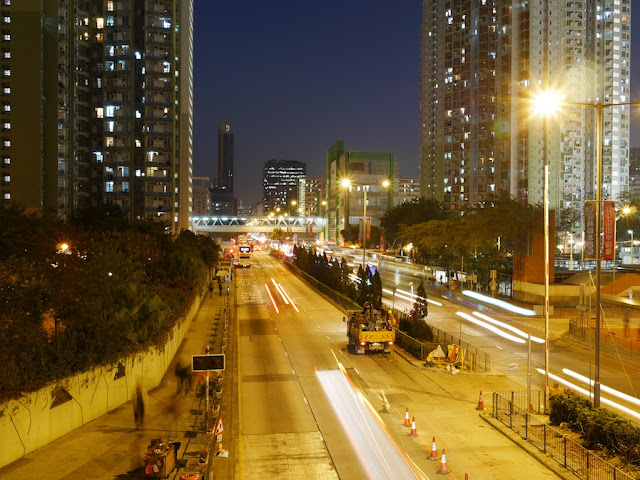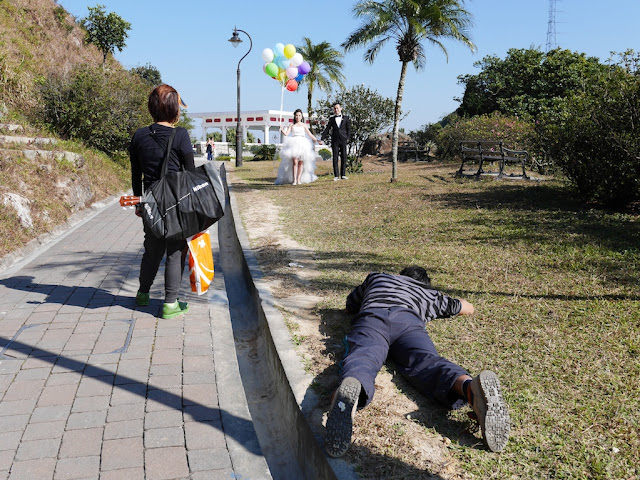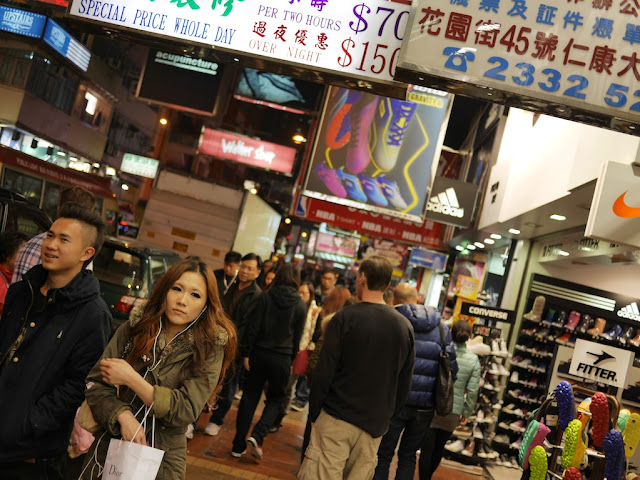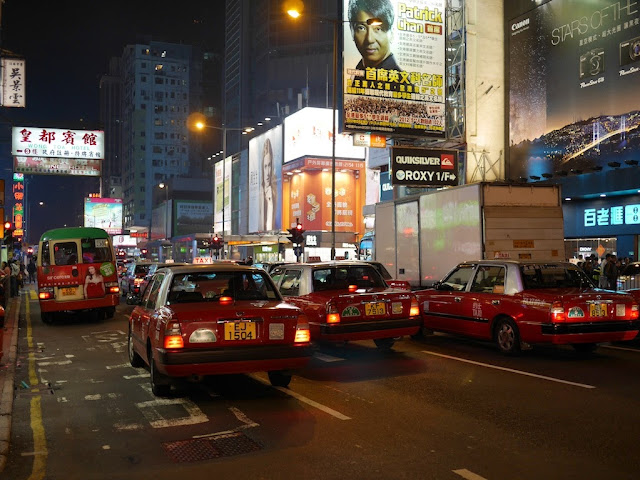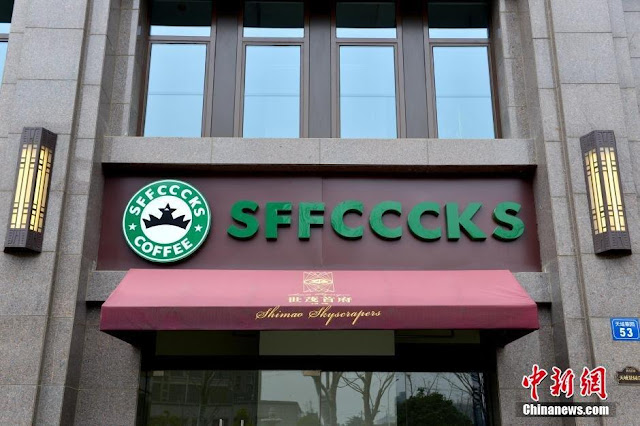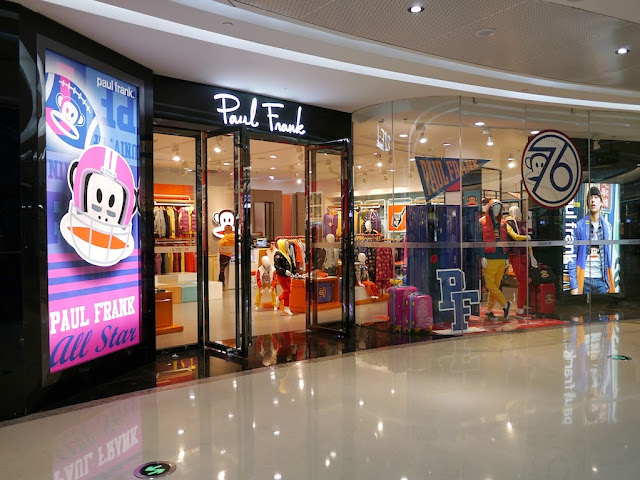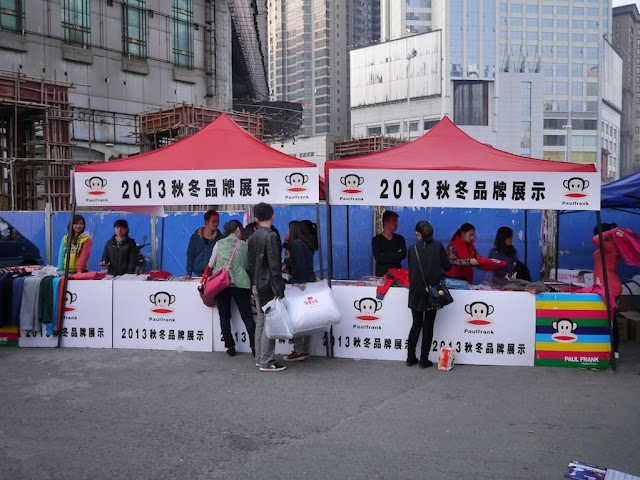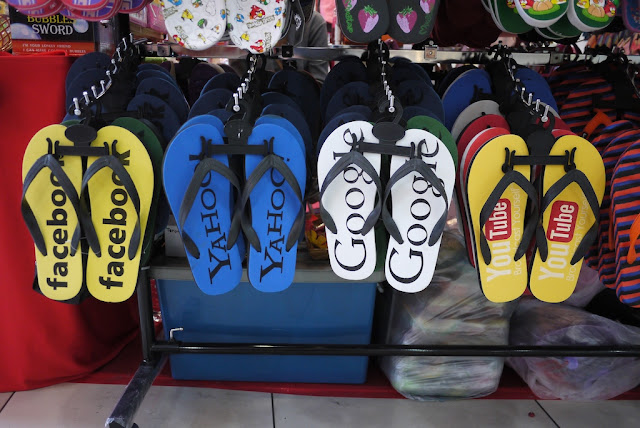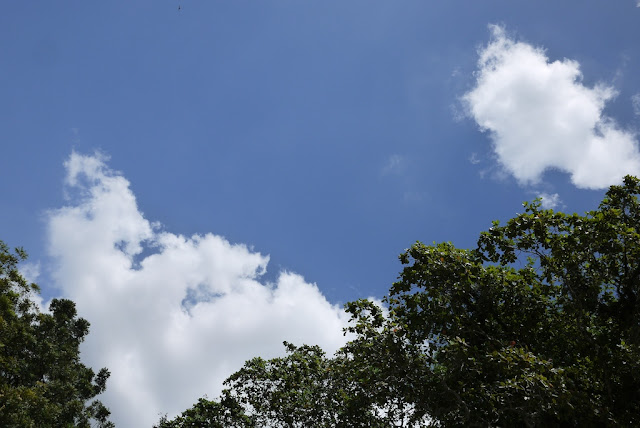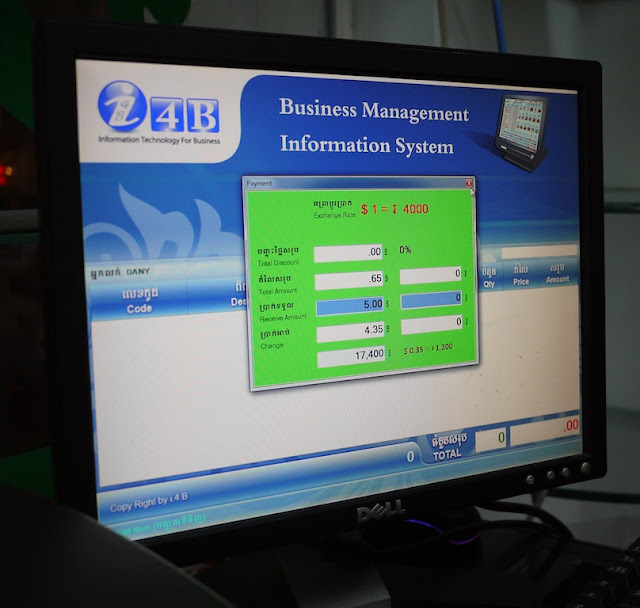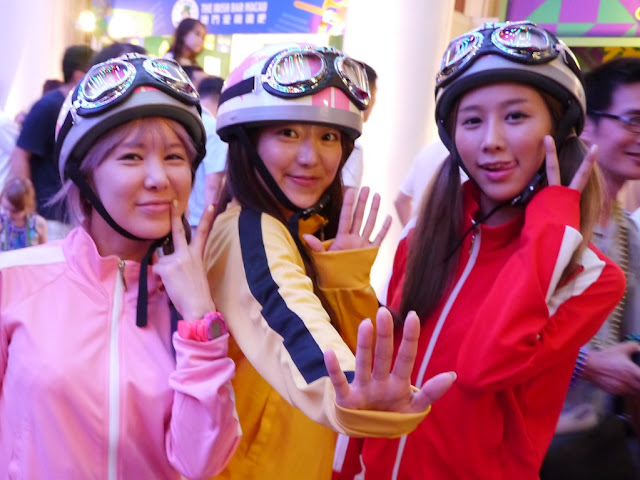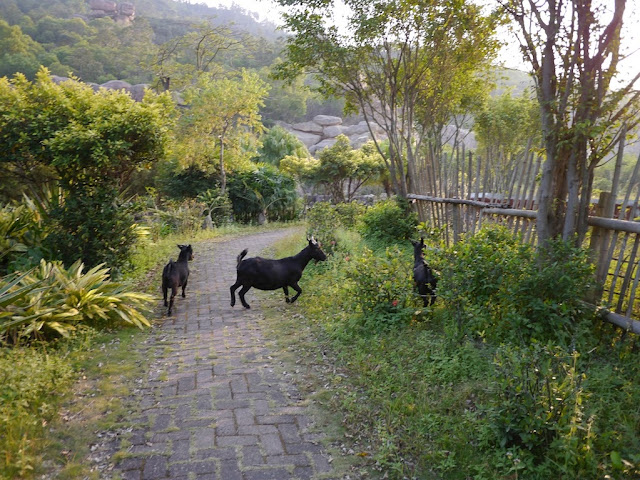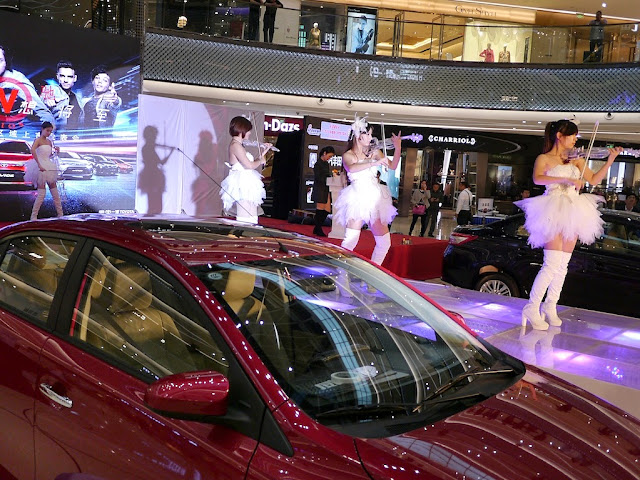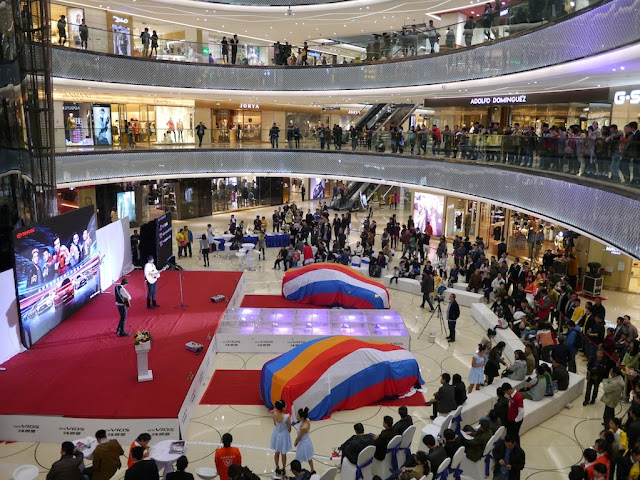Sunday, January 26, 2014
Friday, January 24, 2014
Two Big Circles in China
Posted by
Brian Glucroft
at
7:00 AM
In a post on The Guardian's "Architecture and Design Blog", Oliver Wainwright took a look at "Architecture's trend for cutting holes in buildings". Of the 9 examples he shared, I've seen two in person--both in China. One is Shanghai's World Financial Center. The other is the Guangzhou Circle, which I happened to notice while looking out of a window last November on the second leg of high-speed rail trip from Zhuhai to Changsha. Here's Wainwright's description of the building:
The Guangzhou Circle is off in the distance on the left side of the white pole. Even though it was far away and I wasn't expecting to see it, my eyes were drawn to its unusual shape and color. It reminded me of another building, also based on ancient Chinese coins, in Shenyang. When I arrived in Shenyang over 3 years ago, the Fang Yuan Building was one of the first buildings I saw after leaving the bus station. I had seen photos of it before, but seeing it in person was ... special. I passed much closer to it than the Guangzhou Circle:
Alas, it couldn't have made Wainwright's post since the square center is not a hole. I hope they put the square to good use.
See Wainwright's post here for a closer view of the Guangzhou Circle and to see his other eight selections. The one I'd be most interested to visit is the proposed TEK Center in Taiwan. In the meantime, maybe I should return to the Fang Yuan Building to see what's inside the square section.
As if a giant cable reel had rolled into town and come to rest on the banks of the Pearl River, the newly completed Guangzhou Circle towers 138m above southern China's largest city like a great copper spool. Housing the world's largest stock exchange for raw plastic material, it is the work of Italian architect Joseph di Pasquale, who says the form “will be immediately perceived as a native Chinese landmark.” Because it's big and brash and dressed in a spangly Christmas jumper? Maybe, but also because it is “inspired by the strong iconic value of jade discs and numerological tradition of feng shui.” How so? Because not only does the 50m-wide hole punched through the centre make it look like an ancient Chinese coin, but when the building is reflected in the river it forms the lucky number eight. And an infinity symbol. And the insignia of ancient dynasty that reigned in this area 2,000 years ago.And here is a cropped version of a photo I took from a train:
The Guangzhou Circle is off in the distance on the left side of the white pole. Even though it was far away and I wasn't expecting to see it, my eyes were drawn to its unusual shape and color. It reminded me of another building, also based on ancient Chinese coins, in Shenyang. When I arrived in Shenyang over 3 years ago, the Fang Yuan Building was one of the first buildings I saw after leaving the bus station. I had seen photos of it before, but seeing it in person was ... special. I passed much closer to it than the Guangzhou Circle:
Alas, it couldn't have made Wainwright's post since the square center is not a hole. I hope they put the square to good use.
See Wainwright's post here for a closer view of the Guangzhou Circle and to see his other eight selections. The one I'd be most interested to visit is the proposed TEK Center in Taiwan. In the meantime, maybe I should return to the Fang Yuan Building to see what's inside the square section.
Thursday, January 23, 2014
Hong Kong Zongzi
Posted by
Brian Glucroft
at
5:35 AM
I saw the above zongzi hanging at a takeaway restaurant in Kowloon, Hong Kong, not far from the King George V Memorial Park. As Amy Ma wrote in The Wall Street Journal:
All zongzi features a bamboo-leaf wrapping and is trussed with twine or thin seaweed leaves before it is boiled or steamed until the contents are tender and fully cooked. The shape of the bundle and what's inside – aside from the requisite sticky rice – varies and is often a clue to its geographic origins.I've tried zongzi in many parts of China. If not labeled, their contents can be a mystery, and I sometimes buy them without even asking what's inside. Sometimes the mystery at least partly remains even after I finish eating one. Ma shared the favorite ingredient of a co-founder of a Hong Kong restaurant-review book:
Mr. Fung's weakness is for the glistening globule of fat. "It's like a nugget of treasure that you unearth in the center. The fattier the better," he says, adding that the perfect texture of rice is "QQ," a popular Taiwanese expression for chewy or al dente.To the possible horror of Mr. Fung and some other zongzi connoisseurs, the more health conscious portions of my brain have caused me at times to set aside those glistening globules of fat. In a Seinfeld-ish scene, I can imagine Mr. Fung seeing me do this and him declaring "no more zongzi for you!"
Mr. Fung might be more accommodating though. Whatever the case, fortunately, the world of zongzi remains open to me, and I look forward to new surprises. For more about the history and great variety of zongzi plus some recommendations for where in Hong Kong to try them, see Ma's article here.
Monday, January 20, 2014
Marriage, Birds, Dancing, and Swinging in Hong Kong
Posted by
Brian Glucroft
at
11:54 PM
This past weekend I visited two places in Hong Kong for the first time. Despite the places being new for me, much of what the people were doing I had seen before in Hong Kong.
For example, at the Victoria Peak Garden on Hong Kong Island I saw wedding photography ...
... and bird photography.
And at the King George V Memorial Park in Kowloon I saw dance routines ...
... and kids on a swing set.
Of these four scenes, only the bird photographers surprised me. I had seen a similar group of bird photographers with pricey cameras and lenses at a park in Tsuen Wan, Hong Kong, but it wasn't until I visited Victoria Peak Park that I suspected birding was not uncommon in Hong Kong. For some examples and thoughts on the apparent growing popularity of bird photography in Hong Kong see a recent blog post with photos of birds and birders by John Holmes here.
For example, at the Victoria Peak Garden on Hong Kong Island I saw wedding photography ...
... and bird photography.
And at the King George V Memorial Park in Kowloon I saw dance routines ...
... and kids on a swing set.
Of these four scenes, only the bird photographers surprised me. I had seen a similar group of bird photographers with pricey cameras and lenses at a park in Tsuen Wan, Hong Kong, but it wasn't until I visited Victoria Peak Park that I suspected birding was not uncommon in Hong Kong. For some examples and thoughts on the apparent growing popularity of bird photography in Hong Kong see a recent blog post with photos of birds and birders by John Holmes here.
Friday, January 17, 2014
News Scenes and a New Camera
Posted by
Brian Glucroft
at
11:45 PM
Observant readers may have noticed an absence of "fresh" photos here recently. Instead of sharing a sad story, I'll share something more positive: two photos taken today with my rather new camera.
For more scenes from Mong Kok, one of Hong Kong's densest areas, see the post here which includes photos taken with my previous camera. More photos from both cameras are on the way.
For more scenes from Mong Kok, one of Hong Kong's densest areas, see the post here which includes photos taken with my previous camera. More photos from both cameras are on the way.
Wednesday, January 15, 2014
A Fake But Not So Fake Street in Wuxi, China
Posted by
Brian Glucroft
at
12:38 AM
In a post on Beijing Cream titled "This Wuxi Street Is The Fakest In China", Bernd Chang shared a photo that has been making the rounds in China:
Chang wrote:
The second piece of additional context comes from the new Kaifu Wanda Plaza I recently visited in Changsha. In the "pedestrian promenade" which surrounds the main building, I saw a number of similar signs imitating popular brands. For example:
As in Wuxi, all of the signs were for vacant stores. I didn't see any similar examples there for a non-vacant store and the shopping center included a large number of what appeared to be genuine foreign brand stores.
Many examples of non-vacant stores imitating foreign brands can be found in China. I've mentioned two examples here and here specifically for Starbucks. So I question whether Wuxi should be awarded the "fakest street" award. If the signs were for open stores, then it would at least top anything I've come across in China. Otherwise, what I saw in Changsha indicates the street in Wuxi is not very unique.
Chang wrote:
H&N, Zare, Hugo BGSS, SFFCCCKS Coffee: these are just some of the counterfeits of famous brands — not the same as “famous counterfeits”… or is it? — you can find on a shopping street in Wuxi, Jiangsu province...I would like to add some additional context. First comes from this tweet by Chris Buckley, a reporter for The New York Times:
Maybe it’s a homage.
SFFCCCKS coffee, anyone? A collection of fake foreign-brand signs for vacant stores in Wuxi: http://t.co/ihTfZZTWdj pic.twitter.com/sBV4ymNn8C
— Chris Buckley 储百亮 (@ChuBailiang) January 8, 2014
A key point mentioned by Buckley is that the stores are vacant. That's not to say the signs aren't interesting, but it's a different story than if these were signs for open stores and not possibly just placeholders.The second piece of additional context comes from the new Kaifu Wanda Plaza I recently visited in Changsha. In the "pedestrian promenade" which surrounds the main building, I saw a number of similar signs imitating popular brands. For example:
As in Wuxi, all of the signs were for vacant stores. I didn't see any similar examples there for a non-vacant store and the shopping center included a large number of what appeared to be genuine foreign brand stores.
Many examples of non-vacant stores imitating foreign brands can be found in China. I've mentioned two examples here and here specifically for Starbucks. So I question whether Wuxi should be awarded the "fakest street" award. If the signs were for open stores, then it would at least top anything I've come across in China. Otherwise, what I saw in Changsha indicates the street in Wuxi is not very unique.
Sunday, January 12, 2014
Paul and Daul Frank for Sale
Posted by
Brian Glucroft
at
11:51 PM
To get back into things after an unexpected "blogging holiday", I'll start with a simple post and share a few photos which include a famous monkey and touch on the variety of shopping venues and large number of imitation products in China.
At the previously featured Kaifu Wanda Plaza in Changsha, Hunan province, I noticed this Paul Frank store:
About a 10-15 minute walk away, I saw this outdoor temporary outlet near a construction area:
Two salespeople claimed the items for sale were genuine Paul Frank.
And finally, I earlier saw what be called a sign of creativity for sale at a bus stop near a shopping district in Zhuhai, Guangdong province:
That very well could be a genuine Daul frank.
I'll refrain from making any deep points and simply say that none of the above struck me as unusual for China.
More later ...
At the previously featured Kaifu Wanda Plaza in Changsha, Hunan province, I noticed this Paul Frank store:
About a 10-15 minute walk away, I saw this outdoor temporary outlet near a construction area:
Two salespeople claimed the items for sale were genuine Paul Frank.
And finally, I earlier saw what be called a sign of creativity for sale at a bus stop near a shopping district in Zhuhai, Guangdong province:
That very well could be a genuine Daul frank.
I'll refrain from making any deep points and simply say that none of the above struck me as unusual for China.
More later ...
Tuesday, January 7, 2014
A Prediction for State-Owned Mall Developers in China
Posted by
Brian Glucroft
at
9:34 PM
Recently I have shared scenes from the site of a future shopping center and a recently opened shopping center in Changsha, Hunan province. On that note, I'll share the eighth of ten predictions for China in 2014 by McKinsey & Company's director Gordon Orr:
In fact, at least at the moment, not all are. More on that topic later.
Mall developers go bankrupt—especially state-owned onesNeither of the developers for the two Changsha shopping centers recently featured here, the Changsha IFS and the Kaifu Wanda Plaza, are state-owned and both shopping centers (especially the Changsha IFS) are what in what I'd consider to be "better locations". But a number of other shopping centers can be found in the same area, and it is easy to wonder whether they will all succeed.
Shopping malls are losing ground to the online marketplace. While overall retail sales are growing, e-retail sales jumped by 50 percent in 2013. Although the rate of growth may slow in 2014, it will be significant. Yet developers have already announced plans to increase China’s shopping-mall capacity by 50 percent during the next three years. For an industry that generates a significant portion of its returns from a percentage of the sales of retailers in its malls, this looks rash indeed. If clothing and electronics stores are pulling back on the number of outlets, what will fill these malls? Certainly, more restaurants, cinemas, health clinics, and dental and optical providers. But banks and financial-service advisers are moving online, as are tutorial and other education services.
I expect malls in weaker locations to suffer disproportionately. These are often owned by smaller developers that can’t afford better locations or by city-sponsored state-owned developers that are expanding into new cities. The weak will get weaker, and while they may be able to consolidate, it’s more likely they will go out of business.
In fact, at least at the moment, not all are. More on that topic later.
Thursday, January 2, 2014
Photos That Nearly Made Here it in 2013
Posted by
Brian Glucroft
at
11:14 PM
When I upload a photo to Picasa it usually means I plan to use it soon in a blog post. But sometimes things don't go as planned. So to start off 2014 here, I will share a mishmash of photos from 2013 that were uploaded but for one reason or another never made their way into a published post. In addition to any descriptions, I'll share links to earlier related posts--all except two from 2013. Together they provide reminders of a tiny bit of what was covered here during the previous year and a hint of some of what else I had hoped to share and write about.
So in chronological order...
2013 for me began celebrating in Kuala Lumpur, Malaysia. After Kuala Lumpur, I went to Penang, where I listened to a woman describe her challenges visiting her son in the US, and later Melaka, where not far from the Melaka River I saw this shop in a mall:
Some of the flip-flops (sandals) for sale caught my attention:
What do all of the brands on these flip-flops have in common? They are all global online services created and based in the US. I didn't see any Baidu, WeChat, or Tencent flip-flops...
Later in Melaka, I think not to far from where I met a young woman seeking forgiveness, I looked up and saw this:
For more about why my time in China has given me a deeper appreciation of blue skies with "normal" clouds, see the 2012 post "Skies and Clouds in China" with scenes from Macau.
After Malaysia, I headed to Phnom Penh, Cambodia, where I documented many examples of people riding pedal-powered vehicles, motorbikes, and motorized-vehicles which were pulling or pushing something. However, there was one example, like one of a coffin being delivered on a motorbike, that I had hoped to share in its own post. I never got around to the post, so here is the photo:
Street vehicles weren't the only thing on my mind in Phnom Penh. For example, at one shop I noticed this screen for a cash register at a small convenience store:
In Cambodia, both US and Cambodian currency are regularly used, and transactions can include both. The above screen is presumably an attempt to make life easier and reduce the number of errors.
While in Cambodia I also went to the riverside town of Kampot. In the countryside I walked to Fish Isle, ate a mysterious sea creature, surprised a little girl by answering her phone call, and explored the area to the north by bike. I didn't share many scenes from central Kampot, but here's one at a large market:
After Cambodia, I went to Vietnam, Taiwan, and the US. No unused uploaded photos from those places, but there's one from my next stop: Seoul, South Korea:
This was one of several MLB (Major League Baseball) stores I saw in Seoul. In the window the logo for the Los Angeles Dodgers can be seen--the same team some men were watching at Seoul's Namdaemun Market.
After returning to China, I had the opportunity to revisit Cheung Chau--one of Hong Kong's outlying islands. While there, I saw this monkey:
I had considered posting the photo without any comment except a title something like "Orange Ennui in Cheung Chau".
Fortunately, ennui wasn't an issue for me on Cheung Chau. Nor was it during my visits to nearby Macau where I saw beer speeding through the streets on the peninsula and these three young women in Cotai:
Almost 2 years ago I shared my experience taking a random bus ride in Zhuhai, Guangdong province. Several months ago I took another random bus ride in Zhuhai. Maybe someday I will share more of what I saw, but for now I will just say I was particularly surprised to hear, and then see, goats:
Also while in Zhuhai, I shared some scenes from a late-night outdoor dining establishment. For a contrast, here's an outdoor dining scene at a pricier establishment:
Usually I enjoy the local Chinese-style seafood in Zhuhai, but this is my favorite place for a smoked salmon sandwich.
Finally, more recently I shared a scene from a restaurant in Changsha--a city where I've seen a lot of change. This is the spicy chicken dish I ate for lunch at the restaurant:
And that brings this unplanned set of photos to a close. Undoubtedly, more photos, experiences, and thoughts from previous years will appear here in the future--as will new ones.
So in chronological order...
2013 for me began celebrating in Kuala Lumpur, Malaysia. After Kuala Lumpur, I went to Penang, where I listened to a woman describe her challenges visiting her son in the US, and later Melaka, where not far from the Melaka River I saw this shop in a mall:
Some of the flip-flops (sandals) for sale caught my attention:
What do all of the brands on these flip-flops have in common? They are all global online services created and based in the US. I didn't see any Baidu, WeChat, or Tencent flip-flops...
Later in Melaka, I think not to far from where I met a young woman seeking forgiveness, I looked up and saw this:
For more about why my time in China has given me a deeper appreciation of blue skies with "normal" clouds, see the 2012 post "Skies and Clouds in China" with scenes from Macau.
After Malaysia, I headed to Phnom Penh, Cambodia, where I documented many examples of people riding pedal-powered vehicles, motorbikes, and motorized-vehicles which were pulling or pushing something. However, there was one example, like one of a coffin being delivered on a motorbike, that I had hoped to share in its own post. I never got around to the post, so here is the photo:
Street vehicles weren't the only thing on my mind in Phnom Penh. For example, at one shop I noticed this screen for a cash register at a small convenience store:
In Cambodia, both US and Cambodian currency are regularly used, and transactions can include both. The above screen is presumably an attempt to make life easier and reduce the number of errors.
While in Cambodia I also went to the riverside town of Kampot. In the countryside I walked to Fish Isle, ate a mysterious sea creature, surprised a little girl by answering her phone call, and explored the area to the north by bike. I didn't share many scenes from central Kampot, but here's one at a large market:
After Cambodia, I went to Vietnam, Taiwan, and the US. No unused uploaded photos from those places, but there's one from my next stop: Seoul, South Korea:
This was one of several MLB (Major League Baseball) stores I saw in Seoul. In the window the logo for the Los Angeles Dodgers can be seen--the same team some men were watching at Seoul's Namdaemun Market.
After returning to China, I had the opportunity to revisit Cheung Chau--one of Hong Kong's outlying islands. While there, I saw this monkey:
I had considered posting the photo without any comment except a title something like "Orange Ennui in Cheung Chau".
Fortunately, ennui wasn't an issue for me on Cheung Chau. Nor was it during my visits to nearby Macau where I saw beer speeding through the streets on the peninsula and these three young women in Cotai:
Almost 2 years ago I shared my experience taking a random bus ride in Zhuhai, Guangdong province. Several months ago I took another random bus ride in Zhuhai. Maybe someday I will share more of what I saw, but for now I will just say I was particularly surprised to hear, and then see, goats:
Also while in Zhuhai, I shared some scenes from a late-night outdoor dining establishment. For a contrast, here's an outdoor dining scene at a pricier establishment:
Usually I enjoy the local Chinese-style seafood in Zhuhai, but this is my favorite place for a smoked salmon sandwich.
Finally, more recently I shared a scene from a restaurant in Changsha--a city where I've seen a lot of change. This is the spicy chicken dish I ate for lunch at the restaurant:
And that brings this unplanned set of photos to a close. Undoubtedly, more photos, experiences, and thoughts from previous years will appear here in the future--as will new ones.
Monday, December 30, 2013
Toyota Puts on a Show at a Mall in Changsha
Posted by
Brian Glucroft
at
11:47 PM
On November 17, I visited the new Kaifu Wanda Plaza in Changsha, China. While there, I saw a promotion for the Toyota Vios, which Wikipedia describes as "a four-door subcompact sedan manufactured by Toyota Motor Corporation primarily for emerging markets in the Asia Pacific region". In an article published November 7, CarNewsChina.com reported:
It included a variety of performances. For example, a pair of foreign men with guitars:
And four women with modern-looking violins and a string bass:
There were also enthusiastic emcees, a fashion show, videos, and young women wearing dresses and tiaras (also appearing in the earlier post here) who appeared to mostly stand around and occasionally provide assistance:
I don't know how many cars sales resulted from the promotion, but at least it drew a crowd:
For more, below is a video of one performance. I was interested in capturing audience behavior as well, so it's from a distance and not the greatest for fully appreciating the performance. I will not be providing a review of the performance (including commenting on the fog machines) other than to say, like the promotion as a whole, it reminded me of others I have seen in China.
The new Toyota Vios has been launched on the China car market. Price starts at 69.800 yuan and ends at 112.800 yuan. The new Toyota Vios debuted on the Shanghai Auto Show in April, it is the cheapest Toyota branded sedan available on the Chinese auto market, competing head to head with cars like the Volkswagen Jetta and the Citroen C-Elysee...Although the content, size, extravagance, etc. vary, I've seen numerous promotions like the one at Kaifu Wanda Plaza elsewhere in China. For now I will refrain commenting about this common form of marketing in China, but to provide an example of how companies are trying to connect with consumers in China and to add some more color to the earlier post about Kaifu Wanda Plaza I will share a few photos and a video of the Vios promotion.
The new Vios is an important car for Toyota in China. The old Vios was very unpopular because it was considered too small and underpowered compared to the competition. The new Vios is larger than the old one, but the engines seem rather old and underpowered.
It included a variety of performances. For example, a pair of foreign men with guitars:
And four women with modern-looking violins and a string bass:
There were also enthusiastic emcees, a fashion show, videos, and young women wearing dresses and tiaras (also appearing in the earlier post here) who appeared to mostly stand around and occasionally provide assistance:
I don't know how many cars sales resulted from the promotion, but at least it drew a crowd:
For more, below is a video of one performance. I was interested in capturing audience behavior as well, so it's from a distance and not the greatest for fully appreciating the performance. I will not be providing a review of the performance (including commenting on the fog machines) other than to say, like the promotion as a whole, it reminded me of others I have seen in China.
Friday, December 27, 2013
A New Shopping Experience in Changsha
Posted by
Brian Glucroft
at
8:46 PM
The site of the future Changsha IFS is still a huge pit, but if you're looking for somewhere new (and not cheap) to shop now, about a 15 minute walk away and next to the Xiang River is a site in a very different stage of development. I remember walking through narrow alleys in the area during my first visit to Changsha 4-5 years ago. At the time there were many buildings marked for demolition. Now they are gone, and in their place is Kaifu Wanda Plaza. Its towers appear on the far left side in the night scene I shared here. It opened at the end of September, and according to the developer, Wanda Group:
Of course, while there I took a few photos, and I'll share some below. They were taken on a Monday afternoon & evening. To make a comparison with other shopping environments, see last year's post about the MixC--Shenzhen's largest shopping mall--or last month's post about an outdoor antique market.
The plaza is Changsha's most complete and high level urban commercial complex project. The project has a total construction area of 1.03 million square meters and is comprised of a commercial center, a pedestrian promenade, a luxury five star hotel, business hotel, office buildings and luxury residences. Big name brands from China and overseas have been brought in as tenants including Wanda IMAX, Superstar KTV, Gome Electronics, etc. The plaza's design, layout, construction quality and overall environment will ensure it becomes a key shopping destination for the city of Changsha.Other tenants I saw when I visited last month included foreign brands such as Adidas Kids, Baskin Robbins, Bose, Calvin Klein, Haagen Daz, Lego, and Nautica. With the exception of an area on the first floor, the main building appeared to be mostly occupied, and on a Monday evening there were lines of people waiting to get a table at many of the restaurants on the top floor. The outdoor "pedestrian promenade" surrounding the main building seems to still be getting up to speed and appeared to be at least half vacant. It will be interesting to see what it's like in another year.
The plaza's opening is expected to change Changsha's landscape by upgrading the overall grade of the city as a destination for doing business and for consumers.
Changsha Kaifu Wanda Plaza will bring nearly 10,000 new jobs to the area and provide a steady flow of tax revenue to the local government.
Of course, while there I took a few photos, and I'll share some below. They were taken on a Monday afternoon & evening. To make a comparison with other shopping environments, see last year's post about the MixC--Shenzhen's largest shopping mall--or last month's post about an outdoor antique market.
 |
| This front entrance is surrounded by a huge video display. |
 |
| A view from the 4th floor |
 |
| A view from the 3rd floor |
 |
| A water fountain that can spell Chinese characters wraps around the back of a set of elevators. |
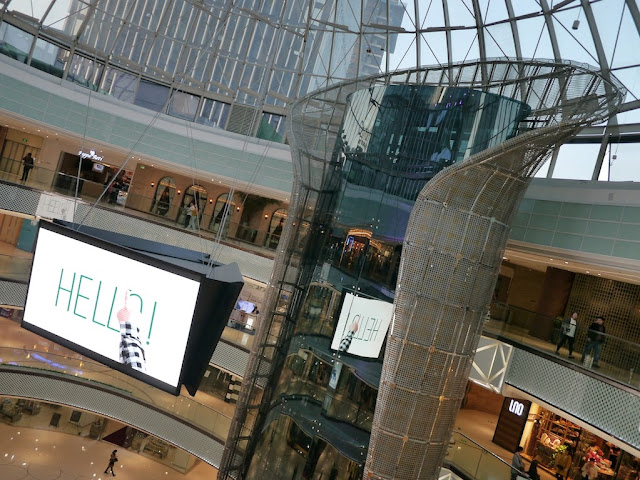 |
| A large video screen next to another set of elevators |
 |
| Looking up at Wanda Plaza's towers |
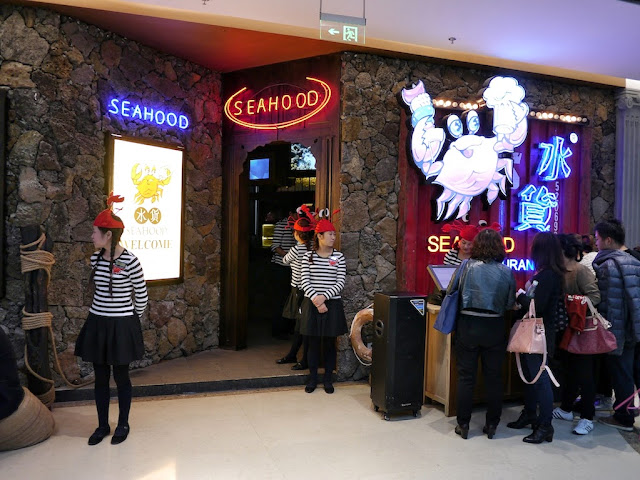 |
| Crab hats are part of the fashion for staff at Seahood. |
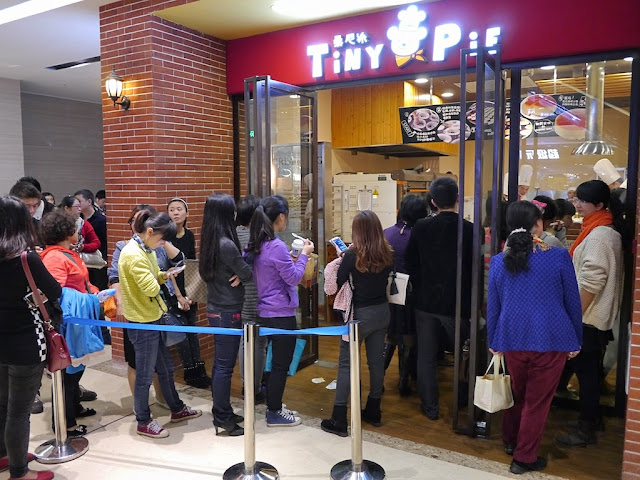 |
| A long line for Tiny Pie |
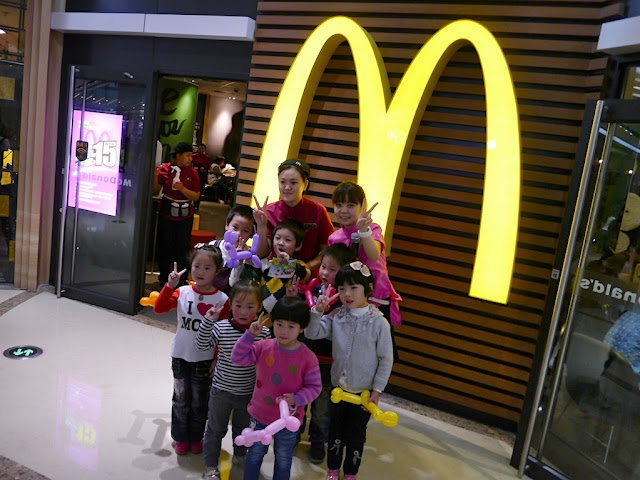 |
| McDonald's staff were entertaining this group of kids. |
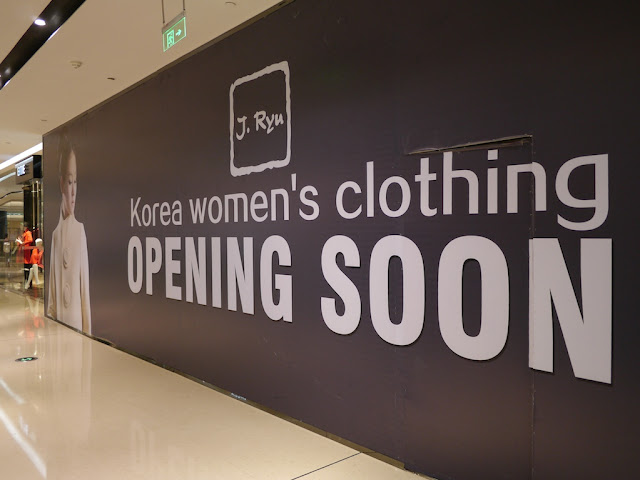 |
| One of the yet-to-open stores |
 |
| A movie theater on the 5th floor |
 |
| A variety of luxury cars are on display, including this Bentley GT V8, at a ground floor store. |
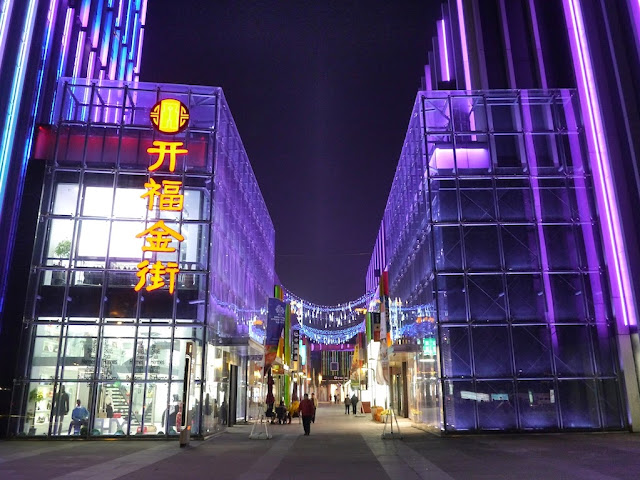 |
| One entrance to the outdoor pedestrian street |
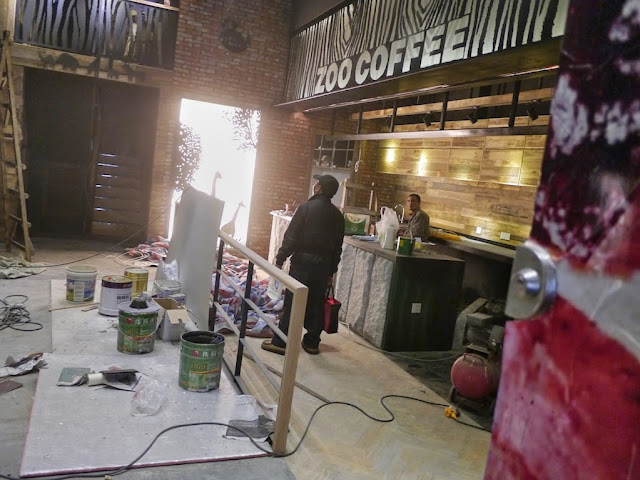 |
| Still more work to complete before Zoo Coffee opens |
Thursday, December 26, 2013
Subscribe to:
Posts (Atom)

